First, let’s talk about Spike’s fight with Appledelhi. This isn’t terribly important to the episode itself, but it’s does offer a good opportunity to talk about some interesting things about the series as a whole… or rather, about the experience of watching it. One of the things I found most striking about the show, when first exposed to it, is the way that the set pieces are bracketed off from the main narrative. I’m talking primarily about the action scenes — fights, chases, and the like — but also about the less showy but equally delirious lyrical setpieces, like the bit where Spike and Faye explore Chessmaster Hex’s garden of hobo delights in Bohemian Rhapsody, or Faye’s flashback from this episode. I used the Lacanian term “jouissance” to describe the sensation evoked by these set-pieces, and it’s worth taking a moment here to explain this concept in slightly greater detail.
It’s often been suggested that our perception of the world, as adults, is wholly different from the way infants see the world, which William James described as “one great blooming, buzzing confusion.” It’s not a question of the infant’s perceptual apparatus being different, but rather a difference in their system of thought. Because they have no conceptual framework to which their perceptions can be connected, they do not look at grass and see “grass,” rather, they see something like “GREEN!:prickly?” And although this is only theorized about infants — because how would you test it? — the difficulties encountered by people like Shirl Jennings suggest that it’s not far from the truth. This also suggests that this kind of overwhelming perception is not unique to infants — we’re all capable of it, we just tune it all out. We have to. How else could we function? Every once in a while, though, we will see (or hear, or what-have-you) something that provokes this response, and it is at these times that we experience jouissance. (Or call it what you will. The sensation is more important than the name.) It’s not enough for the stimulus to be merely unfamiliar. For instance, if I look at this, I don’t feel anything particularly interesting. I don’t know what it is, but it looks enough like a kitchen utensil for me to place it in my conceptual framework for kitchen utensils, even if that doesn’t tell me what to do with it. To provoke that “buzzing confusion,” the object/image/sound must be outside of our conceptual framework. And this is precisely what the set-pieces on Cowboy Bebop accomplish. At least at first.
I say “at first,” because my experience of these sequences has shifted somewhat over the course of the series. Only somewhat, to be sure, but I think predictably. The thing about excess — whether we’re talking about artistic gestures that don’t fit into the standard narrative framework, or the leisure time that we don’t spend in the regimented work/eat/sleep cycle that dominates so much human activity, or the little scraps of cookie dough that are left over after you’ve finished cutting out as many little snowmen (or Christmas trees, or any other non-tessalating holiday iconography) as possible — is that it doesn’t STAY excessive. Rather, you wad it up, roll it out again, and make more snowmen. Which is to say, more generally, that excess generated by one system will be used to generate another system. The set-pieces in Cowboy Bebop stay excessive from the point of view of traditional narrative, but by the time you’ve watched all the way through the series they’re beginning to coalesce into a meaningful system in their own right. At its worst, this effect can destroy the magical sensation of Jouissance (which is sort of beginning to happen for me with the musical numbers on Glee), but I wouldn’t say Bebop has gone that far. At its best, you end up with a situation where the original jouissance, although weakened, is still present, and the new signifying system becomes interesting in its own right. (And of course we should remember that the new system will generate its own excess, and so on right down the line.)
Which brings me back to the fight scenes. For most people, I’ll wager, watching Spike mop the floor with Asimov Solensan in Asteroid Blues didn’t do much to advance plot or character. Oh, we learned that Spike was a badass, I guess, but that was thoroughly incidental to the sequence’s non-diegetic, excessive kickassness. When we look at all of Spike’s kung-fu throwdowns over the course of the series, however, a new system begins to develop. This can basically be expressed by paying attention to the way Spike and his various opponents handle themselves in a fight. One of the truly brilliant things about the fights on Cowboy Bebop is that the people do fight very differently. It’s never just a matter of the coolest-looking thing the animators could think of. As a result, the fights are expressive. They tell us something about the characters and the world they inhabit. Each fight has what can only be described as a value system, something that is very rare in fiction (although see the duels from The Princess Bride) and even rarer in real life (although the classic Ali/Foreman Rumble in the Jungle has at least been read as this), and always special when it happens.
By the time we get to Spike’s fight with Appledelhi, we’ve built up enough of a sense of the way that fights are supposed to go in Cowboy Bebop for the slight differences here to be profoundly affecting. Spike himself, and most of his major opponents, are all about motion. They’re constantly bobbing and weaving, striking where the opponent does not expect and moving out of the way before the opponent can respond. Within that, there are a bunch of other subtle little differences. Pierrot, for instance, is distinct from Spike mainly in that he is so utterly relentless. But the differences between Spike and Appledelhi are not subtle in the least. Spike moves. Appledelhi doesn’t — not unless he has to, not even when a spaceship is threatening to crash into his head. Spike expends immense amounts of energy. Appledelhi doesn’t break a sweat. How well this kind of thing works in actual fights is debatable: Appledelhi’s signature move seems to be the headbutt, which may go some lengths to explaining his apparent brain damage. But it’s a joy to watch, and it makes sense that Spike would lose to him. Spike seems to depend pretty heavily on striking where the enemy does not expect. Appledelhi counters by expecting him to strike exactly where he does.
This might have some interesting implications for the show outside the fight scenes, where after all the characters are struggling not against other characters but against fate, which like Appledelhi is overwhelmingly strong and difficult to trick. Spike’s way of handling the chaos of life is to allow himself to be chaotic, letting go of everything that he can possibly stand to let go of, which turns out to be essentially everything. Appledelhi’s approach is the opposite. The earth is being bombarded with meteors? Screw it, we’ll make a map. But the constant bombardment makes any attempt to — I said screw it, we’re making a map. Again, this may not be a good lesson to apply to your day-to-day life. The series as a whole tends to come down on Spike’s side. But in this particular confrontation, Appledelhi wins. There may be something to that.
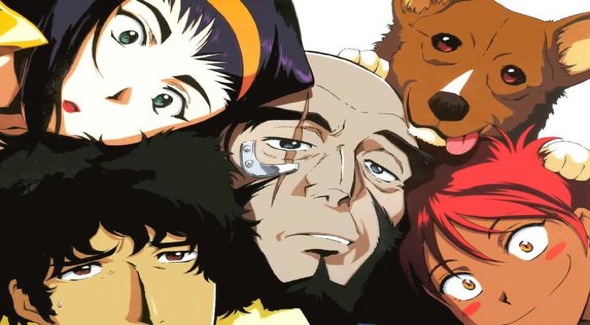
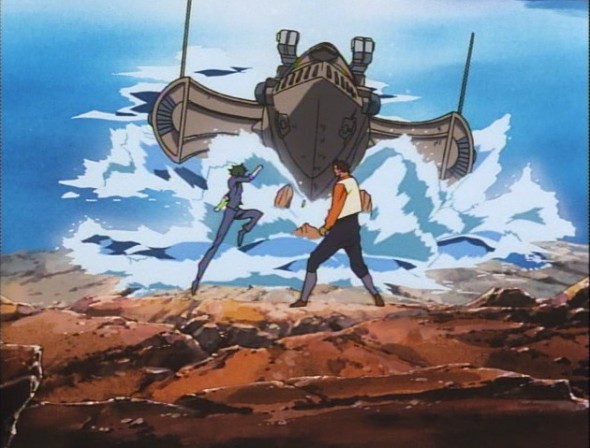
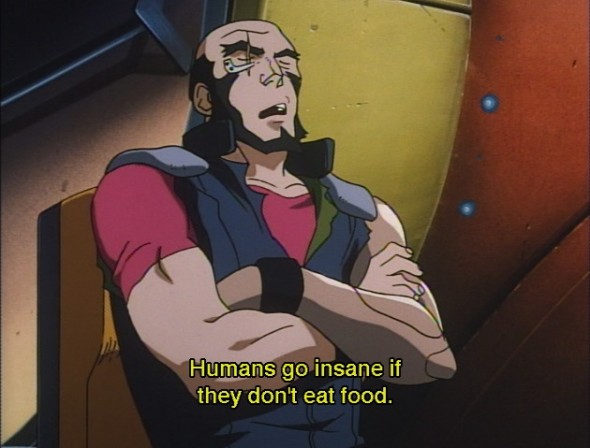
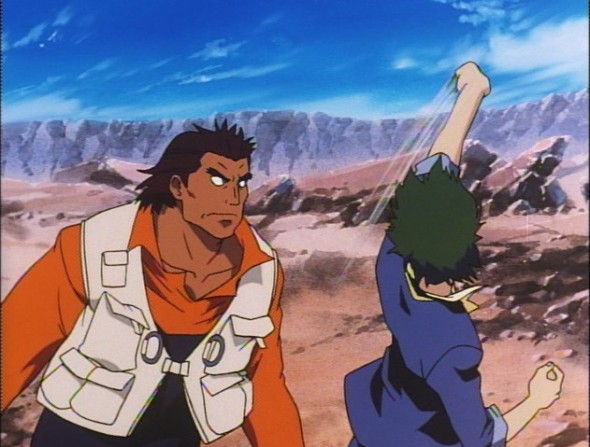
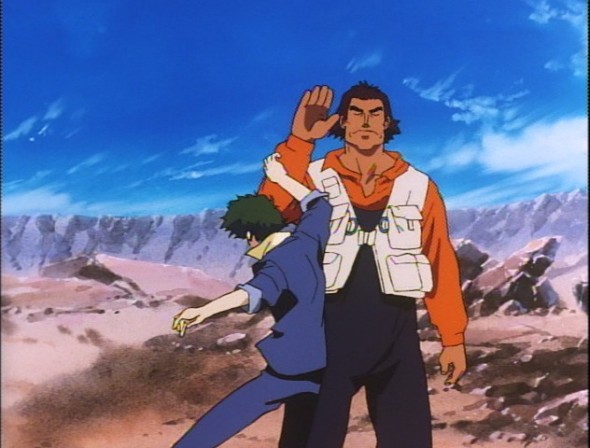
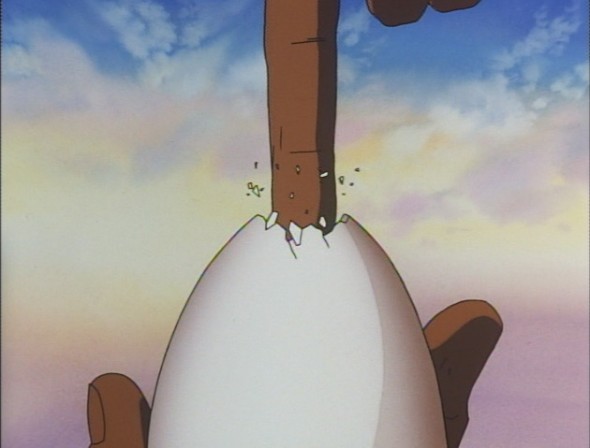
Wow. Mr.Stokes, you have shown me one of my favorite shows in a different light. The surrogate family of Bebop is done in other shows but so well in this one.
I knew I loved this show because it had so much emotion and depth of characters, which not a lot of people would associate with anime unless they’re expose to a lot of it.
Your closing thoughts on the show forced me to reflect on my own surrogate surroundings, and how my group of friends is constantly referred to as a family.
Great work. I need to watch Bebop again. It’s been a few years since I’ve seen it.
I don’t know anything about Cowboy Bebop, but when this popped in my RSS feed, I thought I recognized the lion fountain. Sure enough, later in the article you mentioned Singapore. Here it is:
http://www.flickr.com/photos/xini/364642502/
Speaking of CRT blur, the Star Wars holograms all had that as well. Maybe it’s just a deficincy of holo-technology?
Ha! I like it. Actually, I feel like there are two plausible exceptions. One is that it’s like the control panels with the buttons and dials on the original Star Trek: the writers just didn’t imagine a world where that particular technology had moved forward. The other – probably more likely – is that they realized that the audience would be more likely to accept the image as a projection of some kind if it had recognizable signs of image decay. In Star Wars, this is important because if we were looking at a perfect non-blurry miniature image of Princess Leia kneeling in front of R2D2, we’d be more likely to recognize the signs of image compositing, which would destroy our suspension of disbelief. Bebop doesn’t have this problem, but here it’s actually MORE important, because without the image decay how do you tell the difference between the hologram and “real life?” They would both just be drawings… the “fake” ones need to look different somehow.
Regarding your suggestion that the CRT blur is an effort to help the audience distinguish between the in-universe real/non-real images, I’ve seen the same special effect used in other anime when they depict events via televisions or computer monitors. I first recall the Patlabor movies using it and remember thinking at the time that it was a nifty device.
There is an in-universe explanation for poor radio and hologram quality as well, at least by the Rebel Alliance, to do with concealing identity from the Empire, which is ironically rather parallel to the real reason of concealing other give-aways…
Another lovely article that does a lovely and gut-wrenching episode justice.
Given your in-depth analyses of the Faye-Ed counterpointing, I’d be interested in your thoughts on the (to me) baffling moment right the title card where Faye . . . gives Ed angry mouth to mouth? Engages in anime’s most unappealing girl-on-girl kiss?
I noticed that in the shot where Ed shows up, the line of her neck and profile exactly mirror Faye’s. I liked it visually–it made Ed’s entrance feel that much sneakier having her suddenly pop up while also blending in seamlessly. She really is a weird kid. But maybe with this and the quasi-kiss, there’s also some other parallel–Faye passing on the burden of fruitlessly searching for her family? Faye as Sleeping Beauty (from her cold-sleep/Whitney storyline) literally waking a sleeping Ed up with a kiss?
Final thought: The final moments of the episode show Ed’s pinwheel mounted on the Bebop. I’ve read that in Japan pinwheels are placed on mizuko kuyo shrines for lost, stillborn, aborted, or deceased children. Mizuko kuyo means “water child.” Some relevance to Faye maybe(who’s often associated with water imagery and with whom water, memory and childhood seem to be linked–the water melting off her when she’s defrosted, her shower where she remembers everything, the home video coming via turtle messenger “from the deep,” the Merlion fountain, the fish hallucination from the mushroom episode?)
Here’s a link with pics of some such shrines, with thousands of pinwheels:
http://www.pbase.com/llewiscle/mizuko_kuyo_
Anyways thanks for another great write-up!
That is *super* interesting about the pinwheels! I was wondering about those.
As for the “kiss” thing – your guess is as good as mine. I mean, it’s closer to mouth to mouth than a kiss, because she’s obviously blowing. It’s probably an attempt to wake Ed up completely, and it probably would wake most people up at that. But as to why she would choose THAT method? It is a mystery. The symbolism you suggest could make sense, definitely… makes it kind of a tag-you’re-it moment, I guess.
You went exactly where I did with the idea of a surrogate family. Once you get this point, it gives a very different perspective that colors the rest of the series up to this point, especially regarding Faye. When she shows up, she’s annoying, bitchy, and basically bullies herself onto the Bebop. Retrospectively, though, it’s kind of sweet because you now know enough about her character to understand that she’s subconsciously searching for family, and more overtly looking for somewhere to “belong,” as she says to Edd.
So now you can look back at her decision to join up with Jet and Spike, which essentially takes just long enough for her to announce she’s going to take a shower. Just like that, she insinuates herself into the family, dysfunctional as it is. Earlier her complaining made her look like a spoiled bitch, but looking back, it appears more like familial banter, and her tiffs with Spike can seem more like a sibling rivalry (with a bit of sexual tension). The writers do a great job showing the crew growing as a family while the series progresses without overtly demonstrating it.
And this episode is damned well done. They’re at the point where they can say a great deal without any dialogue. I don’t have it where I can review, but I remember a great scene from this one where Jet yells something at Faye when she gets back to the Bebop, and she stops and gives him a look and…she just looks so lost. It’s something that should be just entirely beyond anime’s ability to pull off, but it’s great. Just like the scene with the eggs at the end-there are simply no words, so just stuff your face while you can.
I thought it was interesting that Faye’s accident was the same one that messed up so many other lives: The exploding of the gate that cracked the moon.
I don’t have your knack for writing or symbolism, Stokes, but I think there’s something here. We’ve seen a lot of lives affected by that event.
So the gate explodes, the moon gets a chunk taken out of it, and life changes. Debris rains down on the Earth.
– The surface becomes so riddled with asteroids hits that people have to take shelter underground. Cities are devastated, cultures and records are lost, including who Faye was, pre-accident.
– This also eventually drives most of the survivors to space, after new gates are built, leading to the massive colonization that we see throughout the series.
– That creepy immortal kid became that way due to being hit with residue from the explosion.
– Chessmaster Hex set up his whole long-game scheme because he was more concerned about gate safety than his superiors. Considering what happened with one of the gates being built, I’d say he was right to be concerned.
– Though he probably would have gotten distracted by something else, it is these asteroid hits that causes Ed’s father to abandon her in the first place. That’s at least two crew members direct affected by the change. Considering the major details of Jet’s and Spike’s lives revolve around crime, and that crime was probably caused by the frontier-environment of colonization, you could stretch and claim all four have been affected in some way by that explosion.
I need to think about this more…
I hate to burst your bubble but I don’t think Faye’s accident occured during the gate explosion. I believe the moon looks cracked because the widow of the craft is cracked. I also thought it occured as a resut of teh gate explosion; but when you see the moon in prior sessions, it isn’t cracked but is just missing a large chunk.
Joel, I think you’re right — but this doesn’t mean that Bobulus is wrong, exactly. Even if Faye’s accident isn’t the same event as the Gate Accident, it’s still thematically similar, and the way the moon is “cracked” by the window glass is meant to establish that connection. After all, why not have it be an image of the earth that gets distorted? Or the sun, or another spaceship, or the reflection of Faye’s own face? And if you look at the images of the damaged moon — I’ve got one of these up, on the post Wild Horses I think — the missing chunk is pretty close to the pie slice cut out by the broken glass. Roughly the same size, roughly the same location (although not exactly the same).
I was so excited when I came across your writing series about Cowboy Bebop and I’m still thoroughly enjoying these. Nothing particularly fascinating to add here, just appreciation from a film student who adores Cowboy Bebop for many of the reasons you’ve articulated and now for even more reasons I hadn’t spotted before. Makes me want to go back and rewatch the series all over again!
Excellent analysis…the most thorough treatment I’ve ever seen Cowboy Bebop receive. Now that I’m done waxing complimentary, I’d like to chime in some analysis as well. I’m not going to touch anything you’ve already provided because any divergence of opinion is minor and not nearly as thought out and thorough. I think one of the more interesting angles to the series expression of futility is that A) it unites each character in experiences (i.e. misery loves company) further establishing a bond which by series end is VERY strong and B) the futility exists because of the existence of the bond. As you correctly surmise, each character is more successful before becoming a member of this crack skeleton crew of failure.
I don’t know if the writing team chose to make them fail repeatedly deliberately to tear down the awesome convention of such ensemble shows (in real life…the ‘Oceans’ movies would be an example) or if they decided that each characters own dysfunction would sooner or later trigger the inevitable collapse. Yet, there is a sort of cohesion brought about by series end…I’ll await your analysis of “The Real Folk Blues” before expounding on that one, but because they always seem perched on the edge of the cliff ready to fall, the characters sort of have a binding tie working under pressure. What’s more is inspite of some unsavory characteristics amongst the leads (Faye and Spike in particular are capable of some pretty nasty acts) the audience finds themselves feeling commonality because at the end of the day, even though Spike is the essence of cool and Faye is a femme fatale in the making herself, they’re all human. They screw up, espically because of misjudgements caused by human conditions like arrogance or being impetuous and yet they return together…no matter how much say Faye has screwed the guys over or Spike has cost them financially in being reckless. It’s a persistant theme…but yeah, totally agree…even though it’s not really fleshed out, Faye CLEARLY was in love with Spike (by the way, I missed her running away in Jupiter Jazz as pertaining to Spike..but now that you mentioned it, that does make sense, in fact she’s impressed with him the moment she sees him). Yet in true Bebop fashion…he’s oblivious to her and….I’ll leave the rest to anyone has hasn’t seen the entire series to figure out. Great analysis and I’ll keep reading along…I’m also an amatuer anime watcher…I usually stick with proven ground (like this and Ghost in the Shell, which I’ll check and yes I’m asuming, but if you haven’t watched the Stand Alone Complex series I’d recommend it and I’d love to read your analysis of it, just FYI but it’s got intellectual ground and depths that I think are fascinating, including the changing of bedrock political outlook from the original film). If you’ve seen it..disregard and next time I’ve got nothing to do University-related, I’ll search out your analysis of it, too.
Whoops…I kind of said in real life or to finish the juxtaposition of ensemble example such as the ‘Oceans’ series…which I think is more poorly done, easier to predict (they always win in the end) than any high-end anime I’ve watched. Before anyone jumps on me…I just noticed that.
I know I’m 7 years late to the party here, but there is a beautiful symmetry to the fact that the first thing Faye does when she forces herself onto the Bebop is take a shower, and the last thing she does before she takes off (she thinks) for good, is… take a shower.